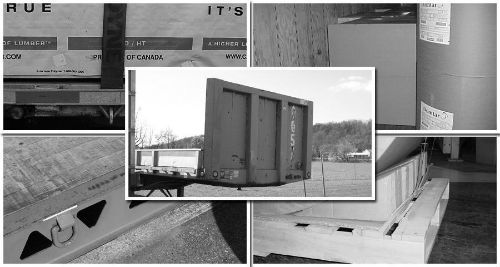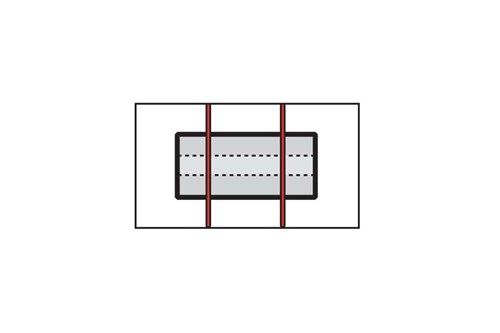CDL Practice Tests: Flatbed Cargo Securement
Choose A Section:
Go!The North American Cargo Securement Standard cover vehicles weighing:
- Over 4,500 lbs
- Over 10,000 lbs
- 26,001 lbs
- Less than 10,000 lbs
North American Cargo Securement Standard
What does the Standard cover? (Section 1.1)
- Commercial vehicles (including a combination of vehicles) that are operated on a highway and have a gross vehicle rating over 4,500 kg (10,000 lb.)
Vehicles
When securing metal coils with eyes vertical, the angle between tiedown and deck, if possible, should be:
- 180 degrees
- Less than 45 degrees
- Between 60 and 90 degrees
- 60 degrees
- Attach at least one tiedown against front of row of coils to restrain against forward motion. If possible, angle between tiedown and deck should be less than 45, when viewed from the side of the vehicle.
- Attach at least one tiedown against rear of row of coils to restrain against rearward motion. If possible, angle between tiedown and deck should be less than 45, when viewed from the side of the vehicle.
- Attach at least one tiedown over top of each coil or side-by-side row of coils to restrain against vertical motion. Tiedowns going over top of coil(s) must be as close as possible to eye of coil.
- Arrange tiedowns, blocking, or bracing to prevent shifting or tipping in all directions.
Which of the following can be used as part of the cargo securement system?
- All of these are valid.
- Vehicle structure.
- Blocking and bracing equipment.
- Securing devices.
What is a securement system?

A securement system is a securement method that uses one or a combination of the following elements:
- Vehicle Structure.
- Securing Devices.
- Blocking and Bracing Equipment.
When securing flattened or crushed cars on a vehicle with containment on 2 sides, how many tiedowns, at minimum, are required?
- 1
- 4
- 2
- 3
Option 3:
Has containment walls on two sides that:
- Extend to the full height of the load.
- Block against cargo movement in the forward and rearward.
Secures each stack of vehicles with a minimum of three tiedowns, each having a minimum WLL of 2,268 kg (5,000 lb.).
Requirements for securing a non-cubic shaped boulder with a stable base include all of the following except:
- Secure each boulder individually with at least two chain tiedowns forming an X pattern over the boulder.
- Pass the tiedowns over the center of the boulder
- Wrap chains around the circumference of the boulder.
- Attach chains together at the intersection

Secure each boulder individually with at least two chain tiedowns forming an X pattern over the boulder.
Pass the tiedowns over the center of the boulder and attach them to each other at the intersection by a shackle or other connecting device.
A device placed between the deck of a vehicle and car or between articles of cargo, intended to provide greater friction than exists naturally between these surfaces is:
- Void filler.
- A chock.
- A friction mat.
- A cleat.
Friction mat:
A device placed between the deck of a vehicle and car or between articles of cargo, intended to provide greater friction than exists naturally between these surfaces.
What is the maximum weight that can be secured by a tiedown with a marked WLL of 5,000 lbs?
- 10,000 lbs
- 6,000 lbs
- 5,000 lbs
- 2,500 lbs
Note: The minimum WLL requirement for the securement system is 50%. More tiedown capacity should be used if you need to secure an article against any movement.
Option #3 for securing metal coils transported with eyes lengthwise includes all of the following except:
- Using blocking or friction mats to prevent forward movement.
- Attaching at least one tiedown over the top of the coil near the rear of the coil.
- Attaching at least two tiedowns through the center of the coil.
- Attaching at least one tiedown over the top of the coil near the front of the coil.
Tiedowns, Single Coil Option #3
Option #3 is the same as Options #1 and #2, except that the two tiedowns that attach through the eye of the coil are replaced with two tiedowns that pass over the front and the rear of the coil.

Attach at least one tiedown over the top of the coil near the front of the coil.
Attach at least one tiedown over the top of the coil near the rear of the coil.
Use blocking or friction mats to prevent forward movement.
When securing building materials, spacer requirements include all of the following except:
- The length of spacers must provide support to all pieces in the bottom row of the bundle.
- Spacers must provide good interlayer friction.
- If spacers are comprised of layers of material, the layers must be unitized or fastened together to ensure that the spacer performs as a single piece of material.
- The height of each spacer must be equal or greater than the width.
Spacer Requirements
- The length of spacers must provide support to all pieces in the bottom row of the bundle.
- The width of each spacer must be equal or greater than the height.
- Spacers must provide good interlayer friction.
- If spacers are comprised of layers of material, the layers must be unitized or fastened together to ensure that the spacer performs as a single piece of material.
Which of the following is not true of Working Load Limit (WLL)?
- All of these are true.
- The WLL is usually assigned by the component manufacturer.
- The minimum WLL requirement for the securement system is 25%.
- The Working Load Limit is the maximum load that may be applied to a component of a cargo securement system.
The Working Load Limit is the maximum load that may be applied to a component of a cargo securement system during normal service.
The WLL is usually assigned by the component manufacturer.
Note: The minimum WLL requirement for the securement system is 50%. More tiedown capacity should be used if you need to secure an article against any movement.
About The Flatbed Cargo Securement CDL Manual
Studying the flatbed cargo securement CDL manual is not a requirement for getting your CDL permit or license. It is required knowledge for flatbed drivers.
Some questions you should be able to answer for flatbed cargo securement:
- What is the minimum Working Load Limit of a tiedown used to secure logs?
- What is the minimum weight of a shipment of paper rolls that would require specific securement requirements?
- When securing concrete pipe over 45 inches loaded crosswise, which direction must the tiedowns on the front half of the load run?
- What is a cab shield?
- When securing concrete pipe over 45 inches loaded crosswise, which direction must the tiedowns on the rear half of the load run?
- What is a dunnage bag?
- Who is responsible for inspecting securing devices and cargo within the first 50 miles?
- How many tiedowns are required on a stack of shortwood loaded crosswise?
- What is the minimum working load limit of each tiedown used to secure crushed or flattened vehicles?
- Define 'bolster'
- What is a hook-lift container?
- When a tiedown is attached directly to the cargo, what is the ideal angle where it attached to the vehicle?
What is a securing device?
Any device specifically manufactured to attach or secure cargo to a vehicle or trailer:
- Synthetic Webbing
- Chain
- Wire rope
- Manila rope
- Synthetic rope
- Steel strapping
- Clamps and latches
- Blocking
- Front-end structure
- Grab hooks
- Binders
- Shackles
- Winches
- Stake pockets
- D-rings
- Webbing ratchet
- Bracing
- Friction mat
What is a tiedown?
A combination of securing devices that forms an assembly that:
- Attaches cargo to, or restrains cargo on a vehicle.
- Is attached to anchor point(s).

Some tiedowns are attached to the cargo and provide direct resistance to restrain the cargo from movement.

Some tie-downs pass over or through the cargo. They create a downward force that increases the effect of friction between the cargo and the deck. This friction restrains the cargo.
 Related Cargo Securement Terms That Every Driver Should Know:
Related Cargo Securement Terms That Every Driver Should Know:
-
Tiedown:
A combination of securing devices which form an assembly that attaches cargo to, or restrains cargo on, a vehicle or trailer, and is attached to anchor point(s).
-
Contained:
Cargo is contained if it fills a sided vehicle, and every article is in contact with or sufficiently close to a wall or other articles so that it cannot shift or tip if those other articles are also unable to shift or tip.
-
Blocking:
A structure, device, or another substantial article placed against or around an article to prevent horizontal movement of the article.
How should tiedowns be attached?
Tiedowns can be used in two ways:
-
Attached to the cargo:
- Tiedowns attached to the vehicle and attached to the cargo.
- Tiedowns attached to the vehicle, pass through or aroundan article of cargo, and then are attached to the vehicle again.
-
Pass over the cargo:
- Tiedowns attached to the vehicle, passed over the cargo, and then attached to the vehicle again.
Tiedown placement:

Place the tiedown as close as possible to the spacer.
Position the tiedowns as symetrically as possible over the length of the article.

Position the tiedowns to preserve the integrity of the article.







 TT On Facebook
TT On Facebook